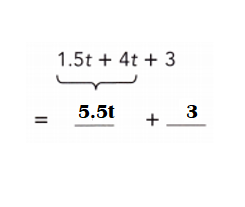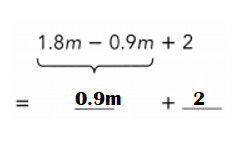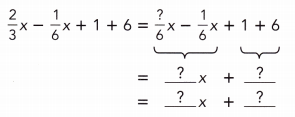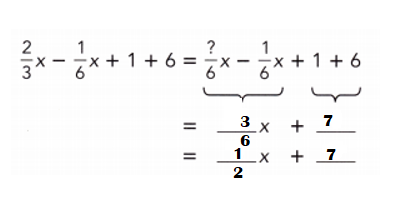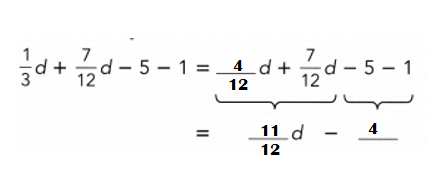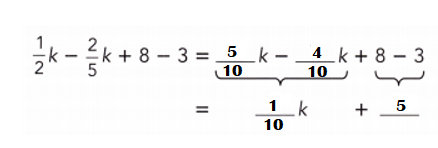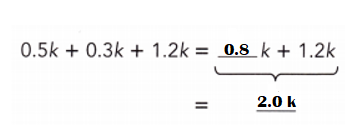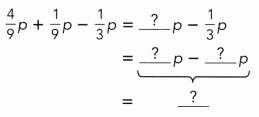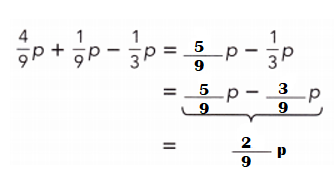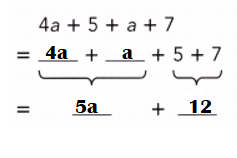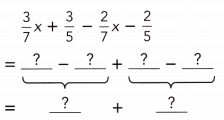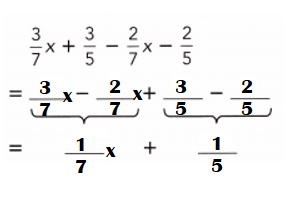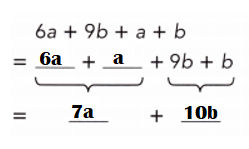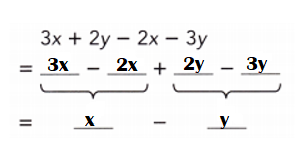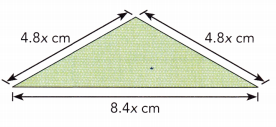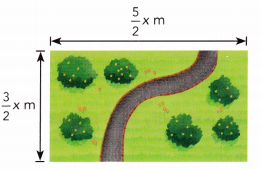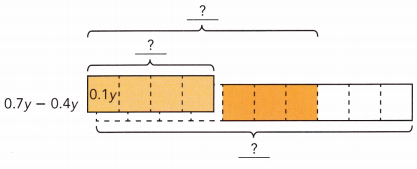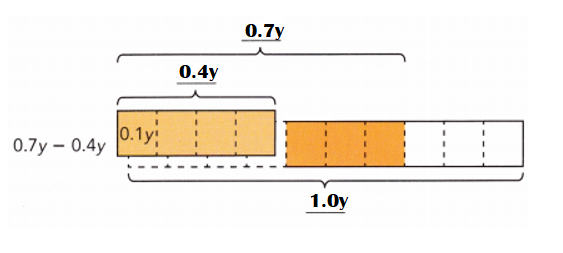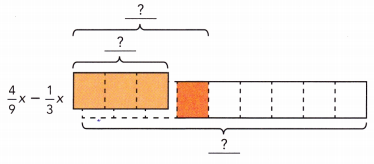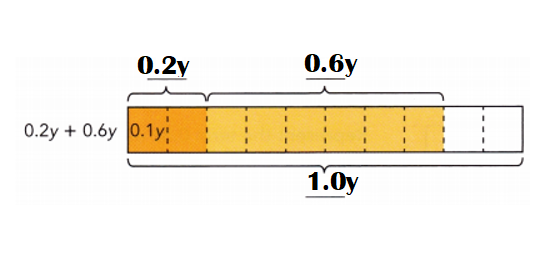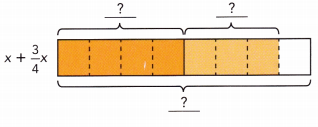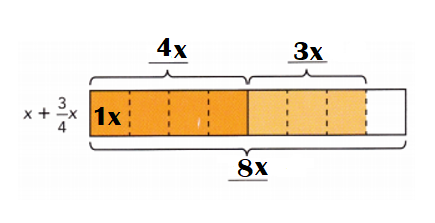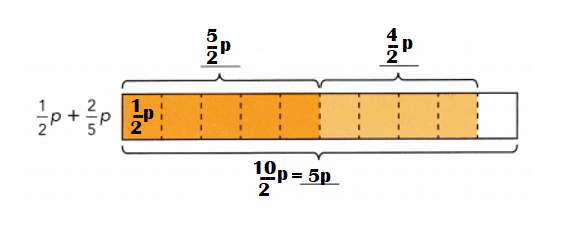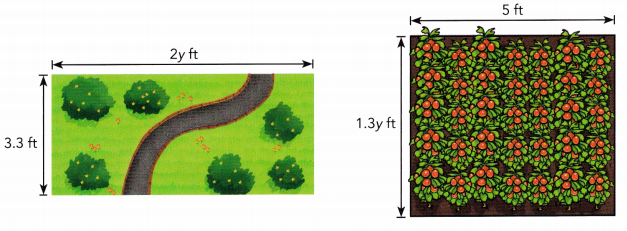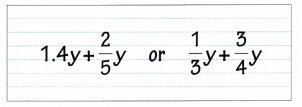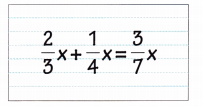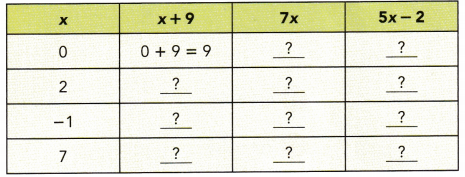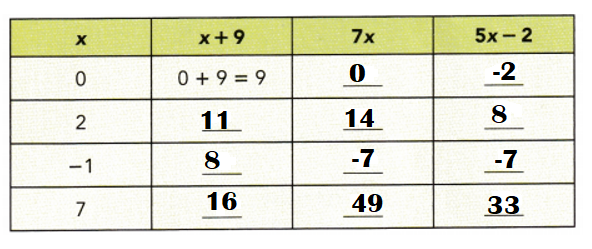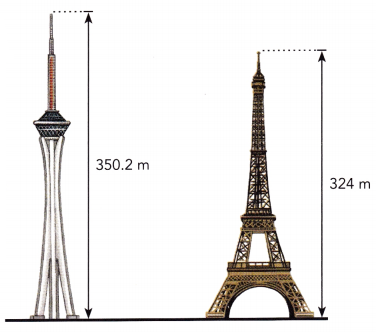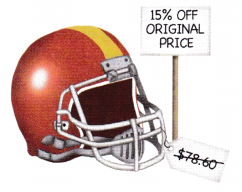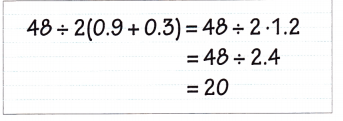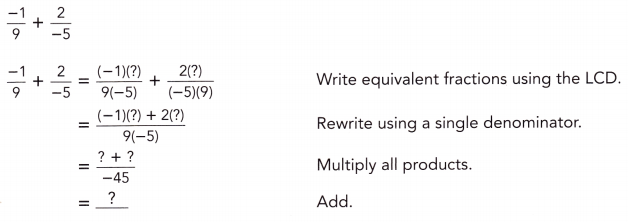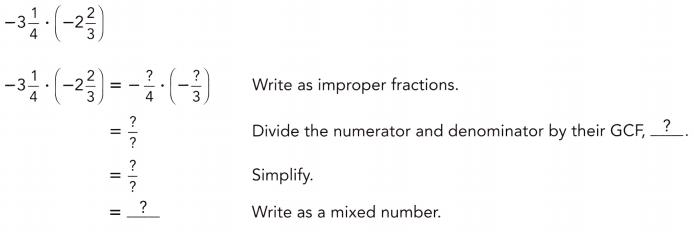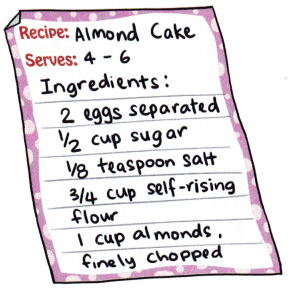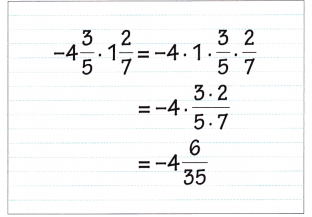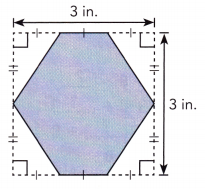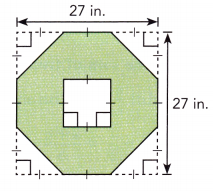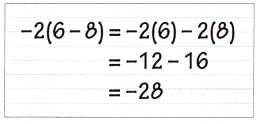Go through the Math in Focus Grade 7 Workbook Answer Key Chapter 3 Lesson 3.4 Expanding Algebraic Expressions to finish your assignments.
Math in Focus Grade 7 Course 2 A Chapter 3 Lesson 3.4 Answer Key Expanding Algebraic Expressions
Math in Focus Grade 7 Chapter 3 Lesson 3.4 Guided Practice Answer Key
Copy and complete to expand the expression.
Question 1.
\(\frac{1}{4}\) (8x + 12)
Method 1
Use a bar model.

From the bar model, \(\frac{1}{4}\)(8x +12) = ![]()
Method 2
Use the distributive property.

Answer:
\(\frac{1}{4}\) (8x + 12) = 2x + 3.
Explanation:
Method 1:
\(\frac{1}{4}\) (8x + 12)
= (\(\frac{1}{4}\) × 8x) + (\(\frac{1}{4}\) × 12)
= 2x + 3.
\(\frac{1}{4}\) (8x + 12) = (2x + 3) + (2x + 3) + (2x + 3) + (2x + 3)
Method 2:
\(\frac{1}{4}\) (8x + 12)
= (\(\frac{1}{4}\) × 8x) + (\(\frac{1}{4}\) × 12)
= 2x + 3.
Expand each expression.
Question 2.
\(\frac{1}{3}\)(9x + 6)
Answer:
\(\frac{1}{3}\)(9x + 6) = 3x + 2.
Explanation:
\(\frac{1}{3}\)(9x + 6)
= (\(\frac{1}{3}\) × 9x) + (\(\frac{1}{3}\) × 6)
= 3x + 2
Question 3.
\(\frac{1}{5}\)(25x + 15)
Answer:
\(\frac{1}{5}\)(25x + 15) = 5x + 3.
Explanation:
\(\frac{1}{5}\)(25x + 15)
= (\(\frac{1}{5}\) × 25x) + (\(\frac{1}{5}\) × 15)
= 5x + 3.
Copy and complete to expand each expression. Write + or – in each ![]() .
.
Question 4.
0.3(2x + 5)
0.3(2x + 5) = 0.3(![]() ) + 0.3(
) + 0.3(![]() )
)
= ![]() +
+ ![]()
Answer:
0.3(2x + 5) = (0.3 × 2x) + (0.3 × 5) = 0.6x + 1.5.
Explanation:
0.3(2x + 5) = (0.3 × 2x) + (0.3 × 5)
= 0.6x + 1.5.
Question 5.
0.5(1.4y – 2.1)
0.5(1.4y – 2.1) = 0.5 (![]() )
) ![]() 0.5(-
0.5(- ![]() )
)
= ![]()
![]() (-
(- ![]() )
)
= ![]()
![]()
![]()
Answer:
0.5(1.4y – 2.1) = (0.5 × 1.4y) + (0.5 × -2.1) = 0.7y – 1.05.
Explanation:
0.5(1.4y – 2.1) = (0.5 × 1.4y) + (0.5 × -2.1)
= 0.7y + (-1.05)
= 0.7y – 1.05.
Expand each expression.
Question 6.
0.4(3y + 2)
Answer:
0.4(3y + 2) = 1.2y + 0.8.
Explanation:
0.4(3y + 2) = (0.4 × 3y) + (0.4 × 2)
= 1.2y + 0.8.
Question 7.
0.2(4x – 3.1)
Answer:
0.2(4x – 3.1) = 0.8x – 6.2.
Explanation:
0.2(4x – 3.1) = (0.2 × 4x) + (0.2 × -3.1)
= 0.8x + (-6.2)
= 0.8x – 6.2.
Expand each expression.
Question 8.
-4(3d – 2)
Answer:
-4(3d – 2) = -12d + 8.
Explanation:
-4(3d – 2) = (-4 × 3d) + (-4 × -2)
= -12d + 8.
Question 9.
-7(5k + e)
Answer:
-7(5k + e) = -35k – 7e.
Explanation:
-7(5k + e) = (-7 × 5k) + (-7 × e)
= -35k + (-7e)
= -35k – 7e.
Question 10.
-4(0.6x – 4)
Answer:
-4(0.6x – 4) = -2.4x + 16.
Explanation:
-4(0.6x – 4) = (-4 × 0.6x) + (-4 × -4)
= -2.4x + (16)
= -2.4x + 16.
Question 11.
–\(\frac{1}{4}\)(-3y + \(\frac{1}{2}\))
Answer:
–\(\frac{1}{4}\)(-3y + \(\frac{1}{2}\)) = \(\frac{3}{4}\)y –\(\frac{1}{8}\)
Explanation:
–\(\frac{1}{4}\)(-3y + \(\frac{1}{2}\))
= (-\(\frac{1}{4}\) × -3y) + (-\(\frac{1}{4}\) × \(\frac{1}{2}\)))
= \(\frac{3}{4}\)y +(-\(\frac{1}{8}\))
= \(\frac{3}{4}\)y –\(\frac{1}{8}\)
Copy and complete to expand and simplify the expression.
Question 12.
2(2a + 3b) + 5b .
2(2a + 3b) + 5b = 2(2 a) + 2 (![]() ) +
) + ![]()
= ![]() +
+ ![]() +
+ ![]()
= ![]()
Answer:
2(2a + 3b) + 5b = 4a + 11b.
Explanation:
2(2a + 3b) + 5b = (2 × 2a) + (2 × 3b) + 5b.
= 4a + 6b + 5b
= 4a + 11b.
Expand and simplify each expression.
Question 13.
-3(\(\frac{1}{2}\)k – 4) – 2k
Answer:
-3(\(\frac{1}{2}\)k – 4) – 2k = –\(\frac{5}{2}\)k + 12.
Explanation:
-3(\(\frac{1}{2}\)k – 4) – 2k
= ( -3 × \(\frac{1}{2}\)k) + (-3 × -4) – 2k
= –\(\frac{3}{2}\)k + 12 – 2k
= (-3k – 2k) ÷ 2 + 12
= –\(\frac{5}{2}\)k + 12.
Question 14.
5(2h – 3) – (2k – 1)
Answer:
5(2h – 3) – (2k – 1) = 10h – 2k – 14.
Explanation:
5(2h – 3) – (2k – 1) = (5 × 2h) + (5 × -3) -2k + 1.
= 10h – 15 – 2k + 1
= 10h – 2k – 14.
Math in Focus Course 2A Practice 3.4 Answer Key
Expand each expression.
Question 1.
\(\frac{1}{4}\) (4x + 8)
Answer:
\(\frac{1}{4}\) (4x + 8) = x + 2.
Explanation:
\(\frac{1}{4}\) (4x + 8)
= (\(\frac{1}{4}\) × 4x) + (\(\frac{1}{4}\) × 8)
= x + 2.
Question 2.
\(\frac{1}{3}\) (6b + 9)
Answer:
\(\frac{1}{3}\) (6b + 9) = 2b + 3.
Explanation:
\(\frac{1}{3}\) (6b + 9)
= (\(\frac{1}{3}\) × 6b) + (\(\frac{1}{3}\) × 9)
= 2b + 3.
Question 3.
\(\frac{1}{2}\) (p + 2)
Answer:
\(\frac{1}{2}\) (p + 2) = \(\frac{1}{2}\)p + \(\frac{1}{4}\)
Explanation:
\(\frac{1}{2}\) (p + 2)
= (\(\frac{1}{2}\) × p) + (\(\frac{1}{2}\) × 2)
= \(\frac{1}{2}\)p + \(\frac{1}{4}\)
Question 4.
\(\frac{1}{5}\) (4a + 3)
Answer:
\(\frac{1}{5}\) (4a + 3) = \(\frac{4}{5}\)a + \(\frac{3}{5}\)
Explanation:
\(\frac{1}{5}\) (4a + 3)
= (\(\frac{1}{5}\) × 4a) + (\(\frac{1}{5}\) × 3)
= \(\frac{4}{5}\)a + \(\frac{3}{5}\)
Question 5.
\(\frac{1}{2}\)(4k – 6)
Answer:
\(\frac{1}{2}\)(4k – 6) = 2k – 3.
Explanation:
\(\frac{1}{2}\)(4k – 6)
= (\(\frac{1}{2}\) × 4k) + ( \(\frac{1}{2}\) × -6)
= (2k) + (-3)
= 2k – 3.
Question 6.
\(\frac{1}{3}\) (16a – 8)
Answer:
\(\frac{1}{3}\) (16a – 8) = \(\frac{16}{3}\)a – \(\frac{8}{3}\).
Explanation:
\(\frac{1}{3}\) (16a – 8)
= (\(\frac{1}{3}\) × 16a) + ( \(\frac{1}{3}\) × -8)
= (\(\frac{16}{3}\)a) + (- \(\frac{8}{3}\))
= \(\frac{16}{3}\)a – \(\frac{8}{3}\)
Question 7.
\(\frac{1}{3}\) (5b – 1)
Answer:
\(\frac{1}{3}\) (5b – 1) = \(\frac{5}{3}\)b – \(\frac{1}{3}\)
Explanation:
\(\frac{1}{3}\) (5b – 1)
= ( \(\frac{1}{3}\) × 5b) + ( \(\frac{1}{3}\) × -1)
= (\(\frac{5}{3}\)b) + (- \(\frac{1}{3}\))
= \(\frac{5}{3}\)b – \(\frac{1}{3}\)
Question 8.
\(\frac{2}{5}\) (k – 10)
Answer:
\(\frac{2}{5}\) (k – 10) = \(\frac{2}{5}\)k – 4.
Explanation:
\(\frac{2}{5}\) (k – 10)
= (\(\frac{2}{5}\) × k) + ( \(\frac{2}{5}\) × -10)
= (\(\frac{2}{5}\)k) + (-4)
= \(\frac{2}{5}\)k – 4.
Question 9.
3(4x + 0.2)
Answer:
3(4x + 0.2) = 12x + 0.6.
Explanation:
3(4x + 0.2)
= (3 × 4x) + (3 × 0.2)
= 12x + 0.6.
Question 10.
4(0.1y + 5)
Answer:
4(0.1y + 5) = 0.4y + 20.
Explanation:
4(0.1y + 5)
= (4 × 0.1y) + ( 4 × 5)
= 0.4y + 20.
Question 11.
0.2(3x + 4)
Answer:
0.2(3x + 4) = 0.6x + 0.8.
Explanation:
0.2(3x + 4)
= (0.2 × 3x) + (0.2 × 4)
= 0.6x + 0.8.
Question 12.
0.6(3h + 5)
Answer:
0.6(3h + 5) = 1.8h + 3.0.
Explanation:
0.6(3h + 5)
= (0.6 × 3h) + (0.6 × 5)
= 1.8h + 3.0.
Question 13.
0.2(m – 3)
Answer:
0.2(m – 3) = 0.2m – 0.6.
Explanation:
0.2(m – 3) = (0.2 × m) + ( 0.2 × -3)
= (0.2m) + (-0.6)
= 0.2m – 0.6.
Question 14.
0.3(p – 3)
Answer:
0.3(p – 3) = 0.3p – 0.9.
Explanation:
0.3(p – 3)
= (0.3 × p) + (0.3 × -3)
= (0.3p) + (-0.9)
= 0.3p – 0.9.
Question 15.
0.4(1.5d + 0.5)
Answer:
0.4(1.5d + 0.5) = 0.6d + 0.20.
Explanation:
0.4(1.5d + 0.5) = (0.4 × 1.5d) + (0.4 × 0.5)
= (0.6d) + (0.20)
= 0.6d + 0.20.
Question 16.
1.2(0.3x – 1.4)
Answer:
1.2(0.3x – 1.4) = 0.36x – 1.68.
Explanation:
1.2(0.3x – 1.4)
= (1.2 × 0.3x) + (1.2 × -1.4)
= (0.36x) + (-1.68)
= 0.36x – 1.68.
Expand each expression with a negative factor.
Question 17.
-2(x + 1)
Answer:
-2(x + 1) = -2x – 2.
Explanation:
-2(x + 1) = (-2 × x) + (-2 × 1)
= (-2x) + (-2)
= -2x – 2.
Question 18.
-3(2x + 5)
Answer:
-3(2x + 5) = -6x – 15.
Explanation:
-3(2x + 5)
= (-3 × 2x) + (-3 × 5)
= (-6x) + (-15)
= -6x – 15.
Question 19.
-3(4a + 9b)
Answer:
-3(4a + 9b) = -12a – 27b.
Explanation:
-3(4a + 9b)
= (-3 × 4a) + (-3 × 9b)
= (-12a) + (-27b)
= -12a – 27b.
Question 20.
-7(2k – h)
Answer:
-7(2k – h) = -14k + 7h.
Explanation:
-7(2k – h)
= (-7 × 2k) + (-7 × -h)
= (-14k) + (7h)
= -14k + 7h.
Question 21.
-4(p + \(\frac{1}{2}\))
Answer:
-4(p + \(\frac{1}{2}\)) = -4p – 2.
Explanation:
-4(p + \(\frac{1}{2}\)) = (-4 × p) + (-4 × \(\frac{1}{2}\))
= (-4p) + × (-2)
= -4p – 2.
Question 22.
–\(\frac{1}{2}\) (6x – \(\frac{1}{3}\))
Answer:
–\(\frac{1}{2}\) (6x – \(\frac{1}{3}\)) = -3x + \(\frac{1}{6}\).
Explanation:
–\(\frac{1}{2}\) (6x – \(\frac{1}{3}\))
= (-\(\frac{1}{2}\) × 6x) + (-\(\frac{1}{2}\) × – \(\frac{1}{3}\))
= (-3x) + (\(\frac{1}{6}\))
= -3x + \(\frac{1}{6}\).
Question 23.
-2(5k + 1.7)
Answer:
-2(5k + 1.7) = -10k – 3.4.
Explanation:
-2(5k + 1.7) = (-2 × 5k) + (-2 × 1.7)
= (-10k) + (-3.4)
= -10k – 3.4.
Question 24.
-3(0.2m + 5)
Answer:
-3(0.2m + 5) = -0.6m – 15.
Explanation:
-3(0.2m + 5)
= (-3 × 0.2m) + (-3 × 5)
= (-0.6m) + (-15)
= -0.6m – 15.
Question 25.
-5(q – 0.3)
Answer:
-5(q – 0.3) = -5q + 1.5.
Explanation:
-5(q – 0.3)
= (-5 × q) + (-5 × -0.3)
= (-5q) + (1.5)
= -5q + 1.5.
Question 26.
-0.6(0.4y – 1)
Answer:
-0.6(0.4y – 1) = -0.24y + 0.6.
Explanation:
-0.6(0.4y – 1)
= (-0.6 × 0.4y) + (-0.6 × -1)
= (-0.24y) + (0.6)
= -0.24y + 0.6.
Expand and simplify each expression.
Question 27.
3(2y + 1) + 4
Answer:
3(2y + 1) + 4 = 6y + 7.
Explanation:
3(2y + 1) + 4
= (3 × 2y) + (3 × 1) + 4
= 6y + 3 + 4
= 6y + 7.
Question 28.
3(2a + 5) – 8
Answer:
3(2a + 5) – 8 = 6a + 7.
Explanation:
3(2a + 5) – 8
= (3 × 2a) + (3 × 5) – 8
= 6a + 15 – 8
= 6a + 7.
Question 29.
2(x + 2) + 3x
Answer:
2(x + 2) + 3x = 5x + 4.
Explanation:
2(x + 2) + 3x
= (2 × x) + (2 × 2) + 3x
= 2x + 4 + 3x
= 5x + 4.
Question 30.
6(b + 3) – 2b
Answer:
6(b + 3) – 2b = 4b + 18.
Explanation:
6(b + 3) – 2b
= (6 × b) + (6 × 3) – 2b.
= 6b + 18 – 2b
= 4b + 18.
Question 31.
5(\(\frac{1}{6}\)a + 1) + 3
Answer:
5(\(\frac{1}{6}\)a + 1) + 3 = \(\frac{5}{6}\)a + 8.
Explanation:
5(\(\frac{1}{6}\)a + 1) + 3
= (5 × \(\frac{1}{6}\)a) + (5 × 1) + 3
= (\(\frac{5}{6}\)a) + 5 + 3.
= \(\frac{5}{6}\)a + 5 + 3
= \(\frac{5}{6}\)a + 8.
Question 32.
4(\(\frac{1}{8}\)a – 3) – \(\frac{1}{2}\)a
Answer:
4(\(\frac{1}{8}\)a – 3) – \(\frac{1}{2}\)a = -12.
Explanation:
4(\(\frac{1}{8}\)a – 3) – \(\frac{1}{2}\)a
= (4 × \(\frac{1}{8}\)a) + (4 × -3) – \(\frac{1}{2}\)a
= \(\frac{1}{2}\)a – 12 – \(\frac{1}{2}\)a
= -12.
Expand and simplify each expression.
Question 33.
0.2(x + 1) + 0.7x.
Answer:
0.2(x + 1) + 0.7x. = 0.9x + 0.2.
Explanation:
0.2(x + 1) + 0.7x
= (0.2 × x) + (0.2 × 1) + 0.7x
= 0.2x + 0.2 + 0.7x
= 0.9x + 0.2.
Question 34.
0.5(y + 2) – 0.3y
Answer:
0.5(y + 2) – 0.3y = 0.2y + 1.0.
Explanation:
0.5(y + 2) – 0.3y
= (0.5 × y) + ( 0.5 × 2) – 0.3y.
= 0.5y + 1.0 – 0.3y
= 0.2y + 1.0.
Question 35.
-2(4 m + 1) – m
Answer:
-2(4 m + 1) – m = -9m – 2.
Explanation:
-2(4 m + 1) – m
= (-2 × 4m) + (-2 × 1) -m
= -8m – 2 – m
= -9m – 2.
Question 36.
10 – 3(2n – 1)
Answer:
10 – 3(2n – 1) = 13 – 6n.
Explanation:
10 – 3(2n – 1)
= 10 + (-3 × 2n) + (-3 × -1)
= 10 – 6n + 3
= 13 – 6n.
Question 37.
-0.8(r + 3) + 2.2r
Answer:
-0.8(r + 3) + 2.2r = 1.4r – 2.4.
Explanation:
-0.8(r + 3) + 2.2r
= (-0.8 × r) + (-0.8 × 3) + 2.2r
= -0.8r – 2.4 + 2.2r
= 1.4r – 2.4.
Question 38.
-(1.2x + 7) + 1.5x
Answer:
-(1.2x + 7) + 1.5x = -7 + 0.3x.
Explanation:
-(1.2x + 7) + 1.5x
= (-1 × 1.2x) + (-1 × 7) + 1.5x
= -1.2x – 7 + 1.5x
= -7 + 0.3x.
Expand and simplify each expression with two variables.
Question 39.
4x + 6(3y + x)
Answer:
4x + 6(3y + x) = 10x + 18y.
Explanation:
4x + 6(3y + x)
= 4x + (6 × 3y) + (6 × x)
= 4x + 18y + 6x
= 10x + 18y.
Question 40.
7a + 5(3a – b)
Answer:
7a + 5(3a – b) = 22a – 5b.
Explanation:
7a + 5(3a – b)
= 7a + (5 × 3a) + (5 × -b)
= 7a + 15a – 5b
= 22a – 5b.
Question 41.
8g + 5(v – g)
Answer:
8g + 5(v – g) = 3g + 5v.
Explanation:
8g + 5(v – g)
= 8g + (5 × v) + (5 × -g)
= 8g + 5v – 5g
= 3g + 5v.
Question 42.
4q + 6(p – 2q)
Answer:
4q + 6(p – 2q) = 6p – 8q.
Explanation:
4q + 6(p – 2q) = 4q + (6 × p) + (6 × -2q)
= 4q + 6p – 12q
= 6p – 8q.
Question 43.
2(a + 2b) + (a + 3b)
Answer:
2(a + 2b) + (a + 3b) = 3a + 7b.
Explanation:
2(a + 2b) + (a + 3b)
= (2 × a) + (2 × 2b) + a + 3b
= 2a + 4b + a + 3b
= 3a + 7b.
Question 44.
3(m – 2n) + 6(n – 2m)
Answer:
3(m – 2n) + 6(n – 2m) = -9m.
Explanation:
3(m – 2n) + 6(n – 2m) = (3 × m) + (3 × -2n) + (6 ×n) + (6 × -2m)
= 3m – 6n + 6n – 12m
= -9m.
Question 45.
4(d + e) – 3(d – 2e)
Answer:
4(d + e) – 3(d – 2e) = d + 10e.
Explanation:
4(d + e) – 3(d – 2e)
= (4 × d) + (4 × e) + (-3 × d) + (-3 × -2e)
= 4d + 4e – 3d + 6e
= d + 10e.
Question 46.
3(3q – p) – (q – 6p)
Answer:
3(3q – p) – (q – 6p) = 8q + 3p.
Explanation:
3(3q – p) – (q – 6p)
= (3 × 3q) + (3 × -p) + (-1 × q) + (-1 × -6p)
= 9q – 3p – q + 6p
= 8q + 3p.
Question 47.
-4(x + 3y) + 3(2x – 5y)
Answer:
-4(x + 3y) + 3(2x – 5y) = 2x – 27y.
Explanation:
-4(x + 3y) + 3(2x – 5y)
= (-4 × x) + (-4 × 3y) + (3 × 2x) + (3 × -5y)
= -4x – 12y + 6x – 15y
= 2x – 27y.
Question 48.
-7(y + 2t) – 3(y – t)
Answer:
-7(y + 2t) – 3(y – t) = -10y – 11t.
Explanation:
-7(y + 2t) – 3(y – t)
= (-7 × y) + (-7 × 2t) + (-3 5 y) + (-3 × -t)
= -7y – 14t -3y + 3t
= -10y – 11t.
Write an expression for the missing dimension of each shaded figure and a multiplication expression for its area. Then expand and simplify the multiplication expression.
Question 49.
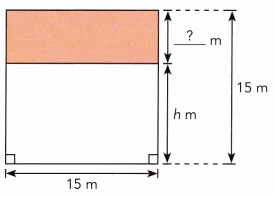
Answer:
Area of the ABCD square figure = 225 square m.
Explanation:
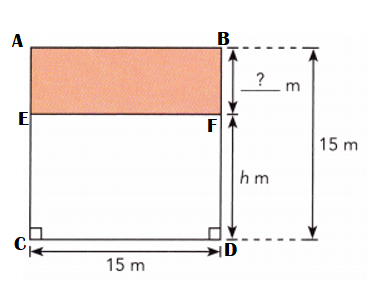
Length of BF shaded figure = BD – BF
= 15 m – h m
= (15 – h) m.
Area of the ABCD square figure = CD × BD
= 15 m × 15 m
= 225 square m.
Question 50.
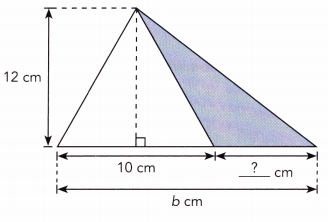
Answer:
Area of triangle ADE = 6b square cm.
Explanation:
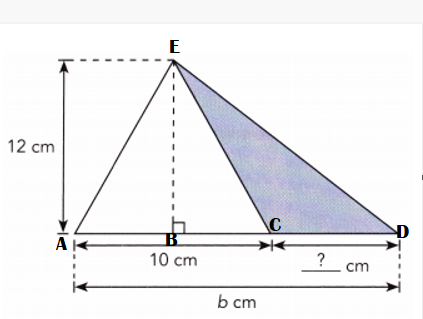
Length of the CD shaded figure :
AD = AC + CD
= b cm = 10 cm + ?? cm
= b cm – 10cm = ?? cm.
Area of triangle ADE = \(\frac{1}{2}\) × base × height
= \(\frac{1}{2}\) × b cm × 12 cm
= 6cm × b cm
= 6b square cm.
Write an expression for the area of the figure. Expand and simplify.
Question 51.
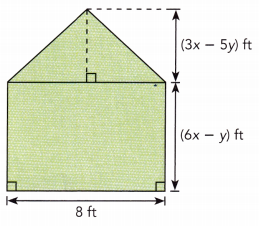
Answer:
Total area of ABCDE figure = (60x – 28y) ft.
Explanation:
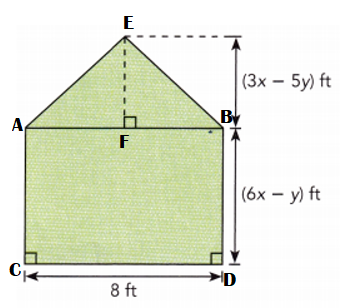
Area of the triangle ABE = \(\frac{1}{2}\) × base × height
= \(\frac{1}{2}\) × 8 ft × (3x – 5y) ft
= 4 ft × (3x – 5y) ft
= (4 × 3x) + (4 × -5y) ft
= (12x – 20y) ft
Area of rectangle ABCD = Length × Width
= 8 ft × ((6x – y) ft
= [(8 × 6x) + (8 × -y)] ft
= (48x – 8y) ft
Total area of ABCDE = Area of the triangle ABE + Area of rectangle ABCD
= (12x – 20y) ft + (48x – 8y) ft
= (12x – 20y + 48x – 8y) ft
= (60x – 28y) ft.

